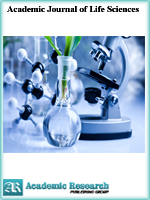Academic Journal of Life Sciences
Online ISSN: 2415-2137
Print ISSN: 2415-5217
Print ISSN: 2415-5217
Quarterly Published (4 Issues Per Year)

Archives
Volume 6 Number 7 September 2020
Photodynamic Therapy Using Endoscopy Capsule Robot
Authors: Sherif Hamdy ElGohary ; Yomna Sabah Mohamed ; Mennatallah Hany Elkhodary ; Omnya Ahmed ; Mennatallah Hesham
Pages: 93-100
DOI: doi.org/10.32861/ajls.67.93.100
Abstract
Among the photosensitizers used in Photodynamic therapy (PDT) technique for cancer treatment, it is found out that the Methylene blue and glycoconjugates chlorine are the best ones for this purpose. In this paper, it is suggested to use Active Capsule Wireless Endoscopy Robot instead of the traditional endoscope. The capsule has many valuable features. It uses LEDs as a source of light in the PDT to kill the colon cancer cells. So, the doctor can make use of the advantage of applying the LED light locally at the tumor which was previously injected by the photosensitizers, the light activates these photosensitizers and a photochemical reaction starts that makes the colon cancer cells die. The light with effective wavelength and power density, energy level and controlled LED light intensity will be applied. Active locomotion capsule endoscopy with an electromagnetic actuation system that can achieve a 3-D locomotion and guidance within the digestive system. The paper also discussed how to manage the required power in the capsule for all parts, LEDs, camera, transceiver, and locomotion.
Effect of Age and Parity on Knowledge of Cervical Cancer Screening Among Women of Child Bearing Age in Anambra State
Authors: Nwankwo Nonyelum Stella ; Ogbalu Anthony Ikechukwu
Pages: 83-92
DOI: doi.org/10.32861/ajls.67.83.92
Abstract
Identification of characteristics of women in terms of age and parity as related to their uptake of existing screening services can give significant data to forming cervical cancer screening administrations. This study was aimed to assess the effect of age and parity on knowledge of cervical cancer screening among women of child bearing age in Anambra State. The study adopted a quasi-experimental research design.The study was conducted at Chukwuemeka Odumegwu Ojukwu University Teaching Hospital Awka and General Hospital Onitsha between June 2019 to September 2019.Using multi-stage (purposive) sampling technique, the sample size for this study consisted of one hundred and eighty four (184) women (134) subjects for experimental group and 50 subjects for control group) attending antenatal in public hospitals in Anambra State. The instrument contained five questions on demographic data of the respondents, questions on knowledge of cervical cancer and practice questions with four point response options. The reliability of the instrument was established by using Cronbach alpha for estimating the internal consistency of the instrument. Data entry and analysis were done using Statistical Package for Social Science (SPSS) and inferential statistics (ANCOVA) was used to test the null hypotheses at 0.05 level of significance.The results showed that all the women of different age groups and women of all parity levels benefitted from the exposure to health education programme. The study therefore concludes that exposing women of child bearing age to health education programme improved the practice of cervical cancer screening practice. The knowledge of cervical cancer, knowledge of cervical cancer screening and knowledge of modes of prevention of cervical cancer are critical in determining cervical cancer screening uptake among the women. It is thus concluded that exposing women of child bearing age to health education programme improved the cervical cancer screening practice than not exposing them to any treatment. With adequate knowledge of cervical cancer and a positive perception of cervical cancer screening, utilization of cervical cancer screening services is uniform among women of all parity level.
Physicochemical, Microbiological and Sensory Characteristics of White Cheese Made by Adding Moringa Oleifera Seeds Extract
Authors: Zakaria A. Salih ; Haifaa AAbdelsalam ; Amna A. Aburigal ; Abdel Moneim E. Sulieman
Pages: 76-82
DOI: doi.org/10.32861/ajls.67.76.82
Abstract
The aim of this study is to investigate physicochemical and sensory properties of cheese made by adding Moringa seeds extract (MSE) as coagulant. Cheese samples were processed by adding 2, 3 and 4% MSE. The results of proximate analysis indicated that moisture content was 40.8, 45.8 and 42.4%, while protein content 16.50, 16, 84 and 16.97 in cheese produced by addition of 2, 3 and 4% MSE, respectively. Statistically, significant differences (p<0.005) were found in both chemical components. The fat content (25.53, 25.72 and 25.92%) in concentrations 2, 3 and 4%, respectively. On the other hand, the highest fat content was found in cheese sample made by adding 4% MSE. The ash content increased by an increase of the concentration of MSE, and the highest value was found in cheese made by addition of 4% MSE (0.82%). Titratable acidity %, pH and The total solids (T.S%) of cheese increased significantly (p<0.005) by an increase of MSE. The mineral content of cheese was statistically affected (p<0.005) by addition of MSE. The microbiological analysis revealed that Colifrom and Salmonella were not detected in processed cheese. The sensory evaluation indicated that all cheese samples were accepted by the panelists with preference to the cheese prepared by 4% MSE. The study recommends using other parts of Moringa Oliefera in cheese coagulation and the effect of storage conditions on the quality of the cheese must be further investigated.
Naturally Scientific Approach to the Treatment of Patients
Authors: Volodymyr Krasnoholovets
Pages: 67-75
DOI: doi.org/10.32861/ajls.67.67.75
Abstract
The present article points to weaknesses of the modern model of healthcare based on pharmacology, which has been unable to resist the influenza virus COVID-19 that led to a planetary economic crisis. The proposed way out of the crisis is to change priorities, namely, the departure from pharmacology and focus on modern science-based natural approaches in the treatment of patients. The three most powerful approaches are described in some detail: water with a high negative redox potential (this is provided by hydrides dissolved in water), information therapy and low-intensity laser therapy. These methods have no side effects and even cure patients with a rejuvenating effect. Undoubtedly, they must be adopted by the healthcare system.



